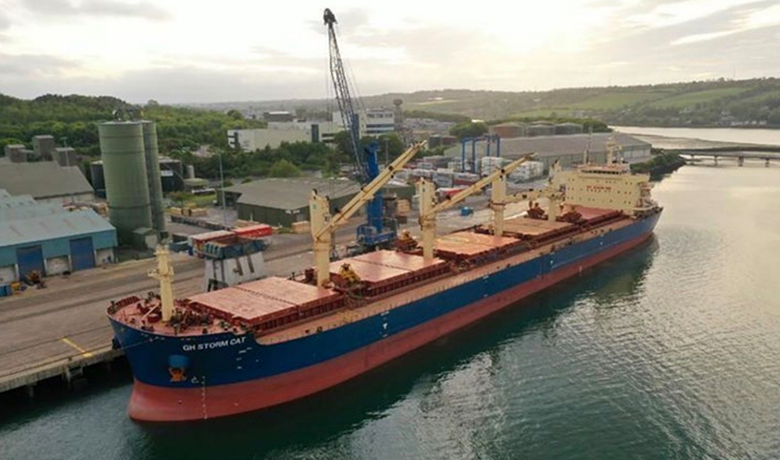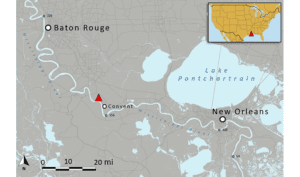

Using a dedicating signalman could have prevented a bulk carrier’s crane boom from hitting a shoreside grain facility on the Lower Mississippi River, federal investigators determined.
The bulker GH Storm Cat’s crane was lifting a payloader machine from a cargo hold to the pier when it hit an elevated conveyor belt known as a runway at the Zen-Noh Grain Corp. (ZGC) facility near Convent, La. The incident happened at about 0910 on Nov. 11, 2020, the National Transportation Safety Board (NTSB) said.
“All ships’ crane lifts — no matter how routine — should be adequately planned and risk-assessed. All personnel involved in the lifting operation should be clearly identified and their duties understood before the start of the lift,” the NTSB said in its report.
The 656-foot GH Storm Cat arrived at the Zen-Noh Grain facility at mile marker 163.8 on Nov. 10 to load corn. Loading proceeded overnight at the 24-hour facility, which used a payloader to even out loads within each cargo hold. An ordinary seaman (OS) aboard the bulker operated the ship’s crane, while a grain company employee drove the vehicle.
Loading was complete within GH Storm Cat’s No. 1 cargo hold at about 0900 on Nov. 11. The OS began the lift at 0906 after a Zen-Noh employee hooked up the payloader. Based on that action, the crane operator mistakenly assumed that the Zen-Noh employee who had hooked up the payloader was the signal person for the lift.
But the Zen-Noh employee told investigators that similar vessels use a crewmember as a signal person, or spotter, to be the crane operator’s eyes and ears on the ground.
A surveillance video shows the Zen-Noh employee attach the crane hook to the payloader, exit the cargo hold, make a hand gesture toward the crane cab and walk out of view of the crane operator. A few minutes later, when the crane operator lowered the boom toward the pier, the tip of the boom hit the facility’s conveyor belt and runway.
“Had the crane operator stopped the lift and attempted to establish communications when he lost visual contact with the ZGC employee, he would have discovered that he was operating without the aid of a signalman, who likely would have noticed the proximity of the crane boom to the runway and could have intervened to prevent the crane striking the structure,” the report said.
The crane operator had experience operating the onboard crane and similar cranes on other vessels, the NTSB said. The agency noted GH Storm Cat’s company manual said the crew should “ensure that the operator and/or the signaler have a clear view for the whole path of travel for the load.”
In 2017, the Occupational Safety and Health Administration (OSHA) published a fact sheet about crane safety at marine terminals. It included a checklist of OSHA requirements and industry best practices, one of which said “employers should verify that … a designated signal person is in place and trained on hand signals.”
The NTSB also emphasized the importance of pre-lift planning and risk assessment. The report noted that the crane operator and Zen-Noh employee, in written post-accident statements, did not mention any efforts to communicate before or during the lift.
Although personnel did not consider the lift complex enough to have a written lift plan, the report said, “their level of planning was clearly inadequate. Both parties involved did not understand who the signalman would be, a critical position in the lift.”
The dockside part of the Zen-Noh facility consisted of four towers connected by elevated, enclosed walkways and conveyor belts known as runways. The crane boom pierced the side of runway No. 3. Damage to the conveyor belt’s structural beam, angle bracing and tin sheets cost an estimated $481,000 to repair. There was no damage to the crane, or injuries to crewmembers.
Hong Kong-based Fleet Management Limited, operator of the Marshall Islands-flagged GH Storm Cat, said in an email statement that it supports the NTSB’s findings. Fleet Management is a subsidiary of the Caravel Group Limited.
Zen-Noh Grain Facility Corp., a U.S. subsidiary of the National Federation of Agricultural Cooperative Associations of Japan, did not respond to a request for comment.
